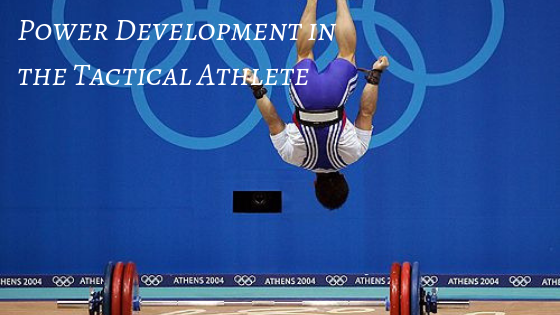Power Development in the Tactical Athlete
Posted on October 17 2019

Olympic lifting has always been known as a great method for producing power in an athlete. Different than the slow moving, heavy squat, many strength and conditioning coaches focus on explosiveness by programming the Olympic lifts. With the many variations, which is better for the Tactical Athlete?
The Olympic lifts are one of the most difficult, most technical lifts that exist today. Chad Wesley Smith of the Juggernaut Method, who has coached both Powerlifters and Olympic Weightlifters to World Records, has stated that in preparation for a competition, a Powerlifter will often spend 10% of his time working on the technical aspects of the squat, bench press and deadlift, and 90% of his time working on strength. The tables turn in Olympic lifting where athletes use submaximal weights 90% of the time to focus on technique. So is it right then to spend all that time in the gym working on something that isn't directly making us, the Tactical Athlete, stronger and more powerful?
The Clean vs the Power Clean:
While there are many ways to develop power in the Tactical Athlete using plyometrics, medicine balls and more, this article focuses on two primary Olympic lifts, the Clean and the Power Clean. First let's break down the difference. The Clean is an explosive movement where the athlete brings the bar from the floor, to the hips, and then drops under the bar, catching it onto their shoulders from a full a&& to grass front squat position before standing.
The Power Clean is the same but instead of dropping to catch the bar, the athlete dips only slightly, catching the bar from a quarter squat position before standing.
The Power Clean, then, explosively moves the bar a greater distance than the Clean. Check out this video of Lydia Valentin performing a full Clean. Notice that the bar essentially only makes it to her belt before she pulls herself under the bar to catch it. Pulling yourself under the bar is incredibly difficult due to the idea that it goes against everything your body is trying to do (lift something heavy). Your legs, which have just lifted something incredibly heavy, are now being asked to completely give out so that you can get under the bar, making this incredibly complex. The Power Clean, however, does not require this movement, only asking that you get the bar up to your shoulders, pulling the entire way through the movement.
While both emphasize power and speed, the Clean arguably focuses a bit more on strength. In a good, technically correct Clean, you are able to lift more weight because the weight doesn't move quite as far, instead dropping your body under it to perform the catch. In the Power Clean, there is less technique requiring you to either get the bar up there into the catch position...or don't. Therefore, there is a bit more emphasis on speed and explosiveness.
So which is best for the Tactical Athlete?
Mark Rippetoe and Lon Kilgore in Practical Programming for Strength Training argue that it is entirely unnecessary for the Tactical Athlete to learn the nuances of the full Clean, and I tend to agree. If it is strength that you want, focus on the big lifts such as the squat, front squat, bench, overhead press and deadlift. If you're ready to translate that strength into power, hit the Power Clean. It is, after all, right there in the name.
How to do it
To perform the Power Clean, conduct the following:
- Stand with your feet shoulder-width apart in front of the barbell with an overhand grip. Grab the bar just outside your knees.
- With a flat back, and shoulders slightly over the bar, stand up pulling the bar up along your shins. This is NOT the explosive part of the lift.
- From just above your knees, extend your hips, knees and ankles as quickly as possibly, shrugging your shoulders upward followed by your elbows. The bar may bounce from your hips and your feet will likely leave the ground at this point.
- With your body fully extended, pull yourself slightly under the bar, rotating your elbows underneath and forward.
- Catch the bar on the front of your shoulders in a quarter-squat position with your chest pointed up along with your elbows. Try not to widen your stance when landing to catch the bar.
- Stand under control to complete the rep.
As mentioned, there are several ways to develop both upper body and lower body power through plyometrics. Yet the Power Clean is an incredible, full body movement that provides a lot of bang for the buck.
Side note: We just released a Power Program specific to the Tactical Athlete including tips and tutorials to help you translate strength into speed. To order or learn more, click here.

2 comments
viagra
buy cialis online